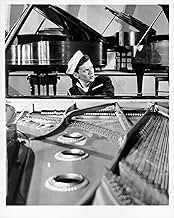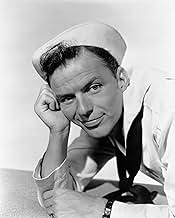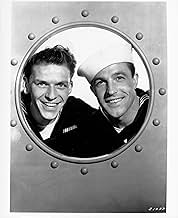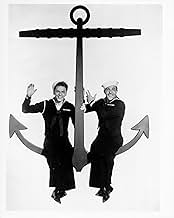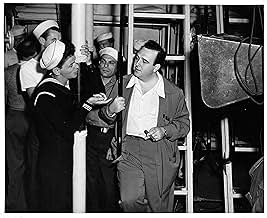VALUTAZIONE IMDb
7,0/10
9811
LA TUA VALUTAZIONE
Un paio di marinai in pausa cercano di aiutare un comparsa cinematografica a diventare un cantante di successo.Un paio di marinai in pausa cercano di aiutare un comparsa cinematografica a diventare un cantante di successo.Un paio di marinai in pausa cercano di aiutare un comparsa cinematografica a diventare un cantante di successo.
- Regia
- Sceneggiatura
- Star
- Vincitore di 1 Oscar
- 5 vittorie e 4 candidature totali
Rags Ragland
- Police Sergeant
- (as 'Rags' Ragland)
Carlos Ramírez
- Carlos
- (as Carlos Ramirez)
Riepilogo
Reviewers say 'Anchors Aweigh' is a classic MGM musical with Gene Kelly, Frank Sinatra, and Kathryn Grayson. It features memorable dance sequences, vibrant Technicolor, and innovative camera work. Themes of love, friendship, and ambition are explored. Songs by Jule Styne and Sammy Cahn enhance the charm. Despite some criticisms of length and pacing, the film is celebrated for its entertainment value and historical significance.
Recensioni in evidenza
In the Citadel film series book The Films of Gene Kelly, Anchors Aweigh is described as a kingpin of a musical. I sure can't do better than that. It's such an important film in both the careers of Gene Kelly and Frank Sinatra. Kathryn Grayson didn't do too badly with this either.
Louis B. Mayer had lent Gene Kelly out to Columbia where Harry Cohn had an inspiration to let Kelly choreograph his own numbers and because of it, Cover Girl became a classic. So if Mayer didn't learn a lesson, producer Joe Pasternak did and allowed Kelly artistic control. When Anchors Aweigh was finished, Fred Astaire at last had a dancing rival for monarch of cinema dance.
The main number everyone talks about with Gene Kelly here is the dance with Jerry Mouse. Originally Kelly wanted to do the number with Walt Disney's Mickey Mouse, but Disney wasn't lending Mickey out to nobody. Mickey would have to wait until Who Framed Roger Rabbit to do an outside film. Not to worry because MGM had it's own animated rodent one half the team of Tom and Jerry.
Kelly as dancer always strived to do something new and different on screen as did Fred Astaire. For the next dozen years, these two were allowed all kinds of artistic control and were praised for their work even if the films themselves weren't up to snuff. It was like each inspired the other to bigger and better creativity, Kelly for MGM, Astaire for MGM and any number of other studios. In Anchors Aweigh, Kelly got Sinatra to dance a bit. In fact Frank Sinatra always gave credit to Gene Kelly for showing him how musicals should be done as he gave credit to both Burt Lancaster and Montgomery Clift for their help in earning him is Oscar for From Here to Eternity.
When Frank Sinatra had half of his contract bought from RKO by MGM he insisted on a little artistic creativity on his own. He'd become friends with the songwriting team of Jule Styne and Sammy Cahn. In his autobiography Sammy Cahn tells about how Sinatra insisted that they write his songs for this film. Louis B. Mayer gave in and the team wrote some really fine ballads for him to sing. One of my favorite Sinatra numbers comes from Anchors Aweigh, I Fall in Love Too Easily. Frank sings it accompanying himself on the piano at an empty Hollywood Bowl. It's Sinatra at his best.
With Jule Styne and later with Jimmy Van Heusen, Sammy Cahn richly earned the title of having put more song lyrics in Frank Sinatra's mouth than any other person. They were lifetime friends and Cahn always credited Sinatra with this milestone boost in his career.
On a bet Styne and Cahn said they could write a song just using a chromatic scale. They proved it in Anchors Aweigh when Kathryn Grayson put her soprano to work on All of a Sudden My Heart Sings. She also did some classical numbers.
Here singing in fact is the basis of the plot. Two sailors on leave through a combination of circumstances meet up with Kathryn Grayson and her orphaned nephew Dean Stockwell. Trying to fix her up with Sinatra, Kelly says he can get her an audition with Jose Iturbi. They spend the film trying to accomplish just that.
My only disappointment in Anchors Aweigh was that Pamela Britton, who plays the waitress 'Brooklyn' never got a number herself. She had gotten rave reviews from her performance as Meg Brockie in Brigadoon on Broadway and that's what brought her to Hollywood. I have a suspicion she had a number that was cut and somewhere in MGM's vaults it might still be.
Anchors Aweigh is a great example of why musicals just aren't made any more. All that creative talent was under contract to Metro-Goldwyn- Mayer. If you had to pay market value for it, the cost might retire some third world country's debt.
But the film results would be extraordinary.
Louis B. Mayer had lent Gene Kelly out to Columbia where Harry Cohn had an inspiration to let Kelly choreograph his own numbers and because of it, Cover Girl became a classic. So if Mayer didn't learn a lesson, producer Joe Pasternak did and allowed Kelly artistic control. When Anchors Aweigh was finished, Fred Astaire at last had a dancing rival for monarch of cinema dance.
The main number everyone talks about with Gene Kelly here is the dance with Jerry Mouse. Originally Kelly wanted to do the number with Walt Disney's Mickey Mouse, but Disney wasn't lending Mickey out to nobody. Mickey would have to wait until Who Framed Roger Rabbit to do an outside film. Not to worry because MGM had it's own animated rodent one half the team of Tom and Jerry.
Kelly as dancer always strived to do something new and different on screen as did Fred Astaire. For the next dozen years, these two were allowed all kinds of artistic control and were praised for their work even if the films themselves weren't up to snuff. It was like each inspired the other to bigger and better creativity, Kelly for MGM, Astaire for MGM and any number of other studios. In Anchors Aweigh, Kelly got Sinatra to dance a bit. In fact Frank Sinatra always gave credit to Gene Kelly for showing him how musicals should be done as he gave credit to both Burt Lancaster and Montgomery Clift for their help in earning him is Oscar for From Here to Eternity.
When Frank Sinatra had half of his contract bought from RKO by MGM he insisted on a little artistic creativity on his own. He'd become friends with the songwriting team of Jule Styne and Sammy Cahn. In his autobiography Sammy Cahn tells about how Sinatra insisted that they write his songs for this film. Louis B. Mayer gave in and the team wrote some really fine ballads for him to sing. One of my favorite Sinatra numbers comes from Anchors Aweigh, I Fall in Love Too Easily. Frank sings it accompanying himself on the piano at an empty Hollywood Bowl. It's Sinatra at his best.
With Jule Styne and later with Jimmy Van Heusen, Sammy Cahn richly earned the title of having put more song lyrics in Frank Sinatra's mouth than any other person. They were lifetime friends and Cahn always credited Sinatra with this milestone boost in his career.
On a bet Styne and Cahn said they could write a song just using a chromatic scale. They proved it in Anchors Aweigh when Kathryn Grayson put her soprano to work on All of a Sudden My Heart Sings. She also did some classical numbers.
Here singing in fact is the basis of the plot. Two sailors on leave through a combination of circumstances meet up with Kathryn Grayson and her orphaned nephew Dean Stockwell. Trying to fix her up with Sinatra, Kelly says he can get her an audition with Jose Iturbi. They spend the film trying to accomplish just that.
My only disappointment in Anchors Aweigh was that Pamela Britton, who plays the waitress 'Brooklyn' never got a number herself. She had gotten rave reviews from her performance as Meg Brockie in Brigadoon on Broadway and that's what brought her to Hollywood. I have a suspicion she had a number that was cut and somewhere in MGM's vaults it might still be.
Anchors Aweigh is a great example of why musicals just aren't made any more. All that creative talent was under contract to Metro-Goldwyn- Mayer. If you had to pay market value for it, the cost might retire some third world country's debt.
But the film results would be extraordinary.
What surprises me here is how good Sinatra is. He's certainly playing against his later cock-sure image. No king of the walk here. Instead his Clarence (note the name) is likable but chock-full of self-doubt. And he's very good at being shy, retiring, and charming in a boyish way. It's a Sinatra as I've never seen him. On the other hand, there's the boldly self-assured Joe (Kelly) who dominates, as the two sailors try to get a big-time audition for the winsome Susan (Grayson). Somehow, however, they can't reach big-time impresario Jose Iturbi. But they and we have a good time trying.
Along the way, Kelly gets his legendary dance with cartoon mouse Jerry of Tom & Jerry, looking like it came right out of the Land of Oz. Then too, I like his really charming number with the little Mexican girl (McManus). Overall, however, it's the elaborate sets, glossy Technicolor, and sparkling personalities that shine. Frankly, I thought the musical selections were entertaining but nothing memorable. Also the storyline meanders a bit too much, particularly near the end. Note too how classical numbers are worked into the selections, quite typical for that time. I guess producers wanted to broaden the musical appeal, and lend a touch of 'class'.
All in all, the movie's MGM at it's glossy best. And though a bit overlong, the results still fit the classic bill, along with the perfect pairing of the two male leads.
Along the way, Kelly gets his legendary dance with cartoon mouse Jerry of Tom & Jerry, looking like it came right out of the Land of Oz. Then too, I like his really charming number with the little Mexican girl (McManus). Overall, however, it's the elaborate sets, glossy Technicolor, and sparkling personalities that shine. Frankly, I thought the musical selections were entertaining but nothing memorable. Also the storyline meanders a bit too much, particularly near the end. Note too how classical numbers are worked into the selections, quite typical for that time. I guess producers wanted to broaden the musical appeal, and lend a touch of 'class'.
All in all, the movie's MGM at it's glossy best. And though a bit overlong, the results still fit the classic bill, along with the perfect pairing of the two male leads.
Famous for the scene where Gene Kelly dances a duet with Jerry Mouse, this zippy musical is also the one where Kathryn Grayson trills 'Jealousy', and Frank Sinatra sings in the arena of a thousand pianos ('I Fall in Love Too Easily'). Grayson is a young mother who wants more than anything else to be in the movies. Her little boy (Dean Stockwell, who would turn up much later in TV's Quantum Leap) wants to join the US forces, and so he meets sailors Kelly and Sinatra heading out for a bit of leave. There are some echoes of 'On the Town' in this movie, but not enough to spoil the mix.
Since I first saw Anchors Aweigh in 1945, viewing it on videotape holds a lot of nostalgia for me. At age 15, it was easy for me to be drawn into the first of the great MGM Technicolor musicals. Now I am perhaps most interested in thinking about the future careers of the leading players. Though Sinatra had done a couple of negligible films soon after his emergence after his Dorsey days, as a solo singer, this was his first major film appearance. As another viewer noted, this seems almost to be a warm-up for On the Town. Sinatra may have had to work hard at it, but his dance with Kelly is credible, and he would do better in their next pairings. However, observing his physique, it's easy to see why he was caricatured as a string bean. Who would have imagined that within a decade he would win an academy award for acting, and go on to play many roles as a tough detective or leader in combat. Though Gene Kelly's personality and dancing dominated this film, his winsome performance did not suggest that he would become a major creative force, almost the iconic figure, for MGM musicals, where he developed a style of dance complementary to that of Fred Astaire. Finally, it was strange to see the fresh-faced Dean Stockwell and remember that he would later play a "thrill" killer in Compulsion, based on the Leopold-Loeb murder from the 1920s. An additional note: One reviewer praised the performance of Betty Garrett as Sinatra's love interest. She later played opposite him in On the Town, but Pamela Britton was featured in this film.
I love these old musicals where they seemed to throw in everyone under contract with the studio. I love the classical music, with Iturbi's very old school highly arched fingers doing amazing things on the keyboard while he also conducted. I love bringing in the next generation of performers. I love the silliness. I love Gene Kelly giving the studio insurance agents palpitations in the bandit scene and calling Kathryn Grayson "Aunt Susie." I love the whole wonderful mishmash. There's something for everyone and if it runs long, well, you can pick which musical number to miss for your bathroom break. :) I wish all the songs were credited at the end but that wasn't the custom then. This has one of my two favorite on screen renditions of the Hungarian Rhapsody. The other was done by Bugs Bunny being bedeviled by a mouse. These musicals are time capsules of great talents, fashions, musical tastes, and movie techniques. I've seen this many times and I hope to see it many more.
Lo sapevi?
- QuizWhen the dance sequence with Gene Kelly and Jerry Mouse was screened for MGM executives, someone noticed that, although Gene Kelly's reflection shone on the floor during his dancing, Jerry's did not. This required animators William Hanna, Joseph Barbera, and their team to go back and draw Jerry's reflection on the floor as he was dancing.
- BlooperWhen Clarence is singing to the waitress in the restaurant, there is a picture of Susita on the wall. When seen at a distance, her head is tilted to the left, but in a closeup, her head is vertical.
- Citazioni
Jerry Mouse: Look at me, I'm dancing.
- Curiosità sui crediti[in some versions, after the end credits]
TO FAMILIES AND FRIENDS OF SERVICEMEN AND WOMEN:
Pictures exhibited in this theatre are given to the armed forces for showing in combat areas around the world.
WAR ACTIVITIES COMMITTEE MOTION PICTURE INDUSTRY
- ConnessioniEdited into American Masters: Gene Kelly: Anatomy of a Dancer (2002)
- Colonne sonoreAnchors Aweigh
(1906) (uncredited)
Music by Charles A. Zimmerman
Played off-screen during the opening credits
Played by a Navy Band conducted by José Iturbi
I più visti
Accedi per valutare e creare un elenco di titoli salvati per ottenere consigli personalizzati
- How long is Anchors Aweigh?Powered by Alexa
Dettagli
- Data di uscita
- Paese di origine
- Lingue
- Celebre anche come
- Canta che ti passa
- Luoghi delle riprese
- Azienda produttrice
- Vedi altri crediti dell’azienda su IMDbPro
Botteghino
- Lordo in tutto il mondo
- 2556 USD
- Tempo di esecuzione
- 2h 20min(140 min)
- Proporzioni
- 1.37 : 1
Contribuisci a questa pagina
Suggerisci una modifica o aggiungi i contenuti mancanti



